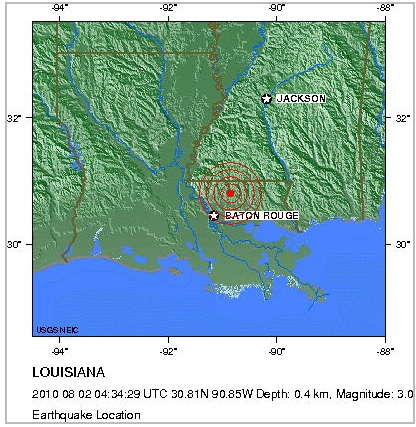In Louisiana Mother Nature is making herself known. After a new earthquake and a sinkhole incident people are wondering what shall they anticipate next? Jack Reed has been following the trail Tactonic Plates in the Gulf area.
Jack Reed is a retired Texaco geologist-geophysist who claims that the current opinions on the Madrid Faultlines are flawed. Reed expects more earthquake activity in the Gulf of Mexico to follow the tactonic events of the last few days in Louisiana. Rift zones, refraction, gravity, magnetics and seismic activity have been changing everything in the Gulf area.
John DiNardo
We have been so consumed by Oil Spillage and Corexit that we may not have seen any Earthquake Activity coming.
Jack Reed has been following the New Madrid Fault Line for years. Check this out for yourself.
Gulf's Evolution Makes the Shakes
Reed, a retired Texaco geologist-geophysicist who has been studying the region's geology for over 40 years, says the accepted theory of a quiet geologic evolution of the Gulf of Mexico Basin is fundamentally flawed and needs to be revised.
According to him, the Gulf was and is tectonically active — and it is the likely origin for not only the New Madrid seismic activity, but also for the Middleton Place-Summerville seismic zone near Charleston, S.C.
"For all the years I have worked the Gulf of Mexico Basin I have been forced to accept the 'passive' Gulf formation theory, which holds that the only movement in the basin is updip sedimentary loading that moved the salt southward," Reed said. "But there is little evidence to support this theory, and it doesn't fit what is observed geologically or geophysically.
"As Hugh Wilson said (1993), 'It would be geologically unusual for such a large basin as the Gulf of Mexico to remain almost tectonically undisturbed for 170 million years while major orogenic disturbances repeatedly struck bordering areas.'"
Reed, over the years, has gathered evidence that supports plate motion in the Gulf basin. Thick salt and sedimentary sequences in the basin mask this tectonic motion, but there is enough basin and peripheral evidence to show plate readjustment is occurring — evidence, he says, in the form of volcanics, earthquakes and rift zones that are accompanied by magnetic, refraction, seismic and gravity data.
Questions? Answers!
One piece of this evidence, according to Reed, is the apparent connection of the New Madrid seismic zone with the Gulf rift features to the south.
"This northeast trending earthquake zone appears to connect with the northeast trending Monroe Uplift, the LaSalle Arch and, possibly, to an active seismic zone located in and around Sabine Lake on the Texas-Louisiana border," he said.
This complex of doming and seismic centers is similar to another Cretaceous age triple juncture located in the northeastern Gulf of Mexico Basin. Doming of the DeSoto Canyon High during the Jurassic to Cretaceous created this triple juncture, which includes the Cretaceous Shelf Edge, the Suwannee Strait and the West Florida Escarpment.
If the New Madrid seismic zone is indeed part of a triple juncture, he continued, there should be an expression of this limb trending along a line in a northeast direction.
So Reed conducted a study using data from the U.S. Geological Survey's National Earthquake Information Center and the USGS map "Earthquakes in the Conterminous United States." He only studied earthquakes measuring at least magnitude 5, and found that while most of the earthquake centers are random with no alignment, there is a well-defined earthquake trend extending northeastward from the New Madrid seismic zone across the United States to Canada, where it joins with the St. Lawrence River seismic zone.
Within the boundaries of this earthquake alignment there are:
Sixty-one seismic points that have a magnitude of 5 and greater.
Several large earthquakes dating to the early 1800s, all measuring over magnitude 8, all occurring within a couple of months of each other, all centered in a northeast trending line.
The two 5+ earthquakes that occurred earlier this year in northern New York state and southern Indiana.
"There is definitely some form of movement occurring along this trend," Reed said, "and it appears to be active today."
As he continued that trend south of New Madrid he found that it was in line with the Monroe Uplift.
"Suddenly I could see that this area had doming much like I had seen at the Desoto Canyon in the Gulf," he said. "This entire zone through the United States is suffering some type of tectonic activity that I believe is tied to the deeply buried tectonics in the Gulf of Mexico."


























No comments